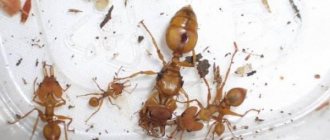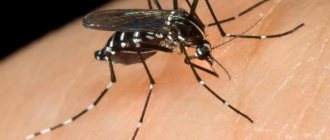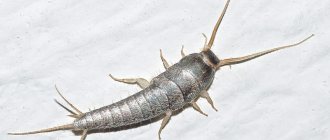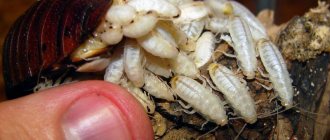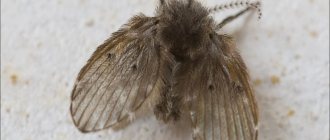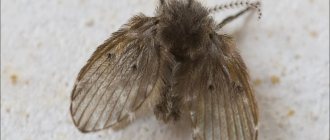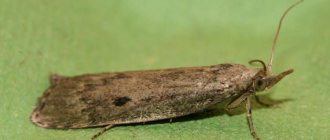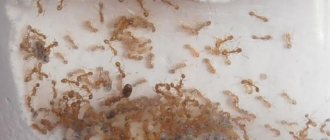Pasta dishes, flour products, porridges are foods that are included in the diet of every person. The ingredients necessary for preparing dishes, namely, a variety of bulk products, are available in the kitchen of every housewife, often with a significant supply.
And what an unpleasant surprise for the housewife is the moment when, if she wants to prepare something from the specified products for breakfast or dinner, in the bins, in addition to cereals, an additive is found in the form of insects. And you shouldn’t think that insects can only appear in the kitchen of a sloppy housewife; even lovers of cleanliness and order are familiar, oddly enough, with such situations. In the article we will tell you what to do in this situation, how to remove bugs from cereals or flour, and prevent similar precedents in the future.
Causes of pests
The question of where the bugs in cereals come from leads most housewives into a dead end, since it is really difficult to understand where the insects came from in a clean, constantly cleaned room. In most cases, the appearance of bugs is not related to the housewife’s tidiness, but is often due to factors completely independent of her.
The reasons why bugs appear in cereals or flour may be as follows:
- Failure to comply with sanitary and hygienic standards in production.
- Infection of products by insects during storage or transportation.
- The introduction of beetle larvae with bakery products into the house, followed by migration of living creatures into the cereals.
Bugs cannot appear on their own in the kitchen; this must be preceded by one of the described precedents, and the housewife brings larvae into the house with purchased products, which multiply over time and infect the existing supplies.
Why do they start
Various insects enter the kitchen from the market, food kiosk or supermarket, where dried fruits, beans, and pasta are sold. The bugs start:
- due to improper grain processing at the enterprise;
- in case of violation of the storage conditions of the goods;
- in the absence of sanitary control of the content of cereals.
Products infested with insects are sometimes imported by unscrupulous suppliers. Bugs appear in stores when the air is too dry, there is no ventilation, or sanitary standards are not observed.
Types of "food" insects
Before we begin to consider issues related to insect control methods, it is necessary to recognize the “enemy” by sight, namely, to understand how dangerous the opponents are.
Pests that hunt in the kitchen in cereals and flour can belong to one of the following varieties:
- Flour beetle. The parasite is red-brown in color, the size of which does not exceed four millimeters: it enters the house mainly with starch, flour or other powdery products. Bugs often choose flour products as food, however, they do not refuse cereals. A feature of this type of insect is its very rapid reproduction: females lay eggs in the most unexpected places - in cracks, on cabinet shelves, doors, in containers with flour products, which threatens the very rapid spread of living creatures around the house, in search of a new, nutritious habitat.
- Red flour eater. Brown insects with a reddish tint, the length of which is no more than two and a half millimeters, often enter the house with animal food. These “individuals” prefer various cereals with low moisture content, flour with expired shelf life and grain products. Getting rid of the flour beetle is much easier than getting rid of the flour beetle: it is enough to block its access to food sources.
- Bread grinder. This type of bug is most often found in bread, pastries and low-quality food for farm animals, with which they enter the home. When multiplying, they choose medicinal plants, tea, coffee, and grain products as their habitat, and over time they can migrate to book bindings.
- Weevil. The beetle, depending on the variety, can be black or brown in color, is distinguished by a high level of fertility, enters the kitchen most often with rice, however, it also lays claim to buckwheat, barley, and grain products.
- Food moth. Individuals reaching a centimeter in size appear indoors most often as a result of improper storage of products: they enter through a window when ventilating an apartment or through ventilation openings. They live mainly in buckwheat, rice, pasta or dried fruits.
- Bean grain. A rich gray pest with small black spots on its back often affects legumes, however, it can also settle in cereals.
Naturally, not a single housewife is happy about such a neighborhood, and regardless of the criterion, what kind of bugs have infested, she immediately looks for ways to get rid of the insects.
Effective ways to control insects in the kitchen
The answer to the question of how to get rid of bugs in cereals varies, depending on the hostess’s readiness to say goodbye to supplies, and the degree of damage to the food.
If the stocks of cereals and flour in the kitchen are small, but the damage is significant, the most rational thing to do is to throw away the products. Chemicals such as Dichlorvos, Rogneda and other drugs, which are now available in a huge range in stores that sell pest control products, will help completely destroy the bugs and their larvae. Attention should be paid to the absolute disposal of cereals, trying to remove even small residues, and food storage areas must be treated according to the instructions for the purchased product, and then thoroughly rinse all surfaces in the house.
When chemicals are unacceptable in the fight against pests, due to a large number of supplies, the presence of pets in the house or for other subjective reasons, you will have to use traditional methods of resisting insects.
To begin with, it is worth carrying out an audit of existing products and assessing the losses: perhaps some of the cereals can be revived, but more on that a little later. Since bugs are quite harmful insects that can live and reproduce outside containers with cereals, the first thing that needs to be done is to thoroughly treat kitchen surfaces. For this purpose, kitchen shelves are completely cleared of containers with cereals and flour, and unusable products are immediately disposed of. Next, the kitchen utensils where the cereals were stored, cabinets and other nearby surfaces in the kitchen are thoroughly washed using folk remedies for bugs. You can add salt, soda or table vinegar to the water for washing surfaces as effective means that will rid the cabinets not only of adults, but also of larvae. If there are hard-to-reach crevices in the kitchen that cannot be reached with a regular washcloth, they are treated with a spray bottle.
In search of an answer to how to get to insects in inaccessible places, boric acid, which is conditionally safe for humans, but deadly for bugs, can be used: the substance is mixed with honey, powdered sugar or other “treats” for bugs, and placed in a cabinet. You can add flour to the mixture, form balls and place them in the cabinet. The advantage of this method is that not only the insect that tried the bait will die, but also the individuals with which the bug will come into contact: this method is effective in getting rid of pests in places hidden from the owners.
After such manipulations, you will need to dry the cabinets, after which you can put the cereals back, making sure that there are no insects in them, with preliminary preventive folk measures against the re-breeding of pests.
Methods of “reanimation” of food products
There are situations when there is so much product that it is not possible to simply throw it away: the price factor forces us to look for options on how to get rid of bugs in flour and cereals without resorting to radical disposal of stocks.
In such cases, thermal treatment of products comes to the rescue: insects will not be able to survive in temperatures exceeding fifty degrees and below fifteen degrees minus.
If, for example, there are bugs in the cereal, and they are discovered at a stage when the bulk of the product is not damaged, by frying the cereal on a baking sheet in the oven at a temperature of one hundred to two hundred degrees, you can get rid of the insects. A similar result should be expected when placing cereal in the freezer for a period of at least 24 hours.
If there are bugs in the flour, before taking any control methods, you should first sift it. The bulk of adult insects and larvae will remain in the sieve, and so that the remaining pests are destroyed, the flour is dried in the oven at a temperature of fifty degrees for half an hour.
If we are talking about cereals, exposing them to salted water and the sun will help get rid of pests. Bugs are lighter than cereals, so they will float to the surface, which will allow them to be drained along with the liquid. After you get rid of the insects, you will need to waste the cereal, if there is not much of it, dry it in the sun during the hot summer season, or dry it using the resources of the oven.
Application of these creatures
The stoneweed, like the hruschak, is just a pest for many.
But avid fishermen, as well as owners of birds and amphibians, know about the beneficial purposes of larvae. Reptiles, birds, amphibians, and invertebrates eat them with great pleasure. When using larvae as food, you should remember that this is a very high-calorie treat. For example, if you give budgies more than five birds a day, your winged friend can quickly gain excess weight, which, combined with inactivity, leads to obesity. Another purpose of the bonefish is as bait or bait. Fishermen are guaranteed a good catch of roach, chub, rudd and other non-predatory fish. Thanks to its fairly hard shell, the larva does not fly off, holding tightly to any hook. It is used in both bottom and float fishing, as well as in floating equipment.
Mealworms are a commodity in high demand in poultry markets, pet stores and, of course, among fishermen. You can purchase it regularly, even stock up. The larvae are stored for a very long time, up to several weeks. The main thing is to follow simple rules: temperature conditions, good ventilation. But there is another win-win option for those who use boners constantly or want to earn extra money. Cultivation at home. This process does not require large financial investments and physical and time costs.
Basic rules for storing products
Fighting insects in the kitchen with cereals is a thankless and difficult job, and often in the process of getting rid of pests you have to “say goodbye” to existing supplies. Naturally, every housewife will be interested in learning how to properly store cereals and flour products in the house so that bugs do not infest them.
Proper storage first of all involves the need to regularly, at intervals of no more than a week, clean kitchen shelves, and conduct a visual inspection of products for damage, mold or insect breeding. Special attention should be paid to containers for storing products: it is advisable to use hermetically sealed, tightly sealed glass jars or bags made from environmentally friendly materials for these purposes.
The shelf life of products is another factor that can cause insects to appear in cereals. In situations where long-term storage of products is expected, it is advisable to place stickers or other information signs on the container, indicating the date until which the product can be used for food.
Store flour and cereals to prevent bugs from infesting them in dry cabinets, away from sinks and other sources of moisture, since high humidity can accelerate the reproduction of insects if they accidentally enter the house with poor-quality products.
Ventilate the room regularly: fresh air and sunlight are unfavorable factors for most types of food insects.
Prevention of insect breeding
In addition to following storage rules, in order to prevent the appearance of insects in cereals, folk tricks are often used:
- Pests are afraid of substances that have strong odors. Housewives use lavender, bay leaves, and garlic as a deterrent against cereals. Aromatic herbs and spices are placed in fabric, natural bags in cabinets, and garlic can even be placed at the bottom of a container with cereal - this will not affect the taste of the prepared dish.
- Treat containers for storing products before filling them with salted or vinegar-diluted water, followed by drying them without preliminary rinsing.
- Beetles cannot tolerate metal, according to scientists, so a small piece of foil or any metal object placed in a container with cereal will prevent pests from breeding in it.
And one more piece of advice. In order not to look for “working” methods of pest control, not to decide which of them to choose, if you need to destroy the next “offspring”, purchase products in small quantities, as needed. Agree, the risk of breeding bugs is much higher if “bulk” products are stored in bags than in situations where there are several jars of different cereals on the shelf, and it will be much easier to cope with the problem with small stocks of products.
Where are the bugs hiding?
If insects appear in the kitchen, then general cleaning is essential. We'll have to check everything. After all, kitchen pests are practically omnivorous. Neither red pepper nor medicinal herbs scare them.
Note! It is best to complete the search in one day because the bugs can multiply quickly.
The work plan is as follows:
- Sort through all the cereals. If living creatures were found in open packages, then most likely they have already gnawed through the sealed products. Open and check everything!
- Don't forget to check the salt. Perhaps the emerging insects are not connoisseurs of sweets.
- Beans are a favorite delicacy. If dark spots appear on the beans, throw them away. In the future, try to store beans only in the freezer.
- Check all the seasonings and first aid kit. Kitchen pests are partial to ordinary mustard plasters. Be sure to review all packaging.
- Don't forget about tea and coffee. A floating insect in a cup is quite a sight!
- Sort through all the vegetables. Some beetles do not disdain onions.
- Move all the furniture and check the cracks. If during this time you managed to find several clusters of beetles, you will have to check the entire apartment.
- Inspect the window sills and floors.
- Check all equipment. Don't even ignore the iron.
Acceptability of eating bug-infested products
Even when the bug is infested, the temptation to preserve the product by using it for food is often too great, however, it is worth considering how safe such a decision is.
Insects not only feed on cereals, but also lead active life activities in them: they reproduce, secrete enzymes and leave behind excrement, which is difficult to remove even by washing. In addition, too strong and long-standing infestation of products with beetles will also affect the taste of the final dish: insects eat away valuable, useful substances, the so-called “base” of the cereal, leaving only the part of the product that is useless to the body, supplemented by excrement, empty cocoons and other waste products. A prepared dish made from such grains will not only taste bitter, but can also cause an allergic reaction or food poisoning.
When you have livestock, and there are large supplies, you often “don’t have the courage” to throw away the products; however, whether it’s worth risking your personal health is up to you to decide.
Summarizing
Remember, food is the main source of energy and nutrients for a person, and health indicators directly depend on its quality. For cooking, you should use only high-quality, usable ingredients, and cereals with components of the vital activity of food pests are far from the best option for a healthy dish.
The methods presented in the article will help you cope with pests that have conquered the territory of your kitchen, and small tricks, in the form of folk methods for preventing the breeding of beetles, will eliminate the reappearance of insects.
How do uninvited guests appear in a living space?
You purchase kitchen pests from the store yourself. Only moths can fly in. All other insects come to their new place of residence in bags of food. If the package of cereals is transparent, then carefully study what you are going to the checkout with. In addition, new guests may appear in your kitchen from neighbors through ventilation, holes and cracks.
